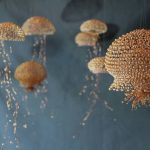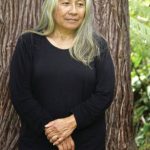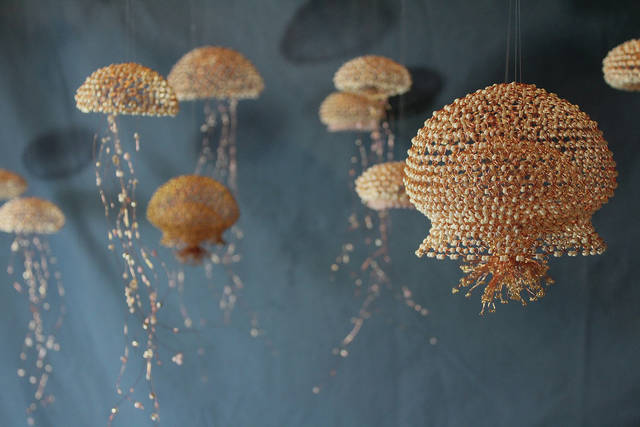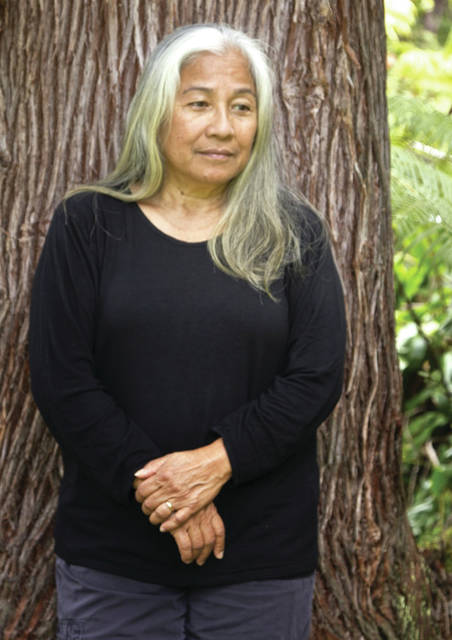Sculpting with inspiration: Kahilu Exhibits featuring nationally recognized artist Bernice Akamine


WAIMEA — A solo exhibition by nationally recognized artist Bernice Akamine opens with a reception and artist’s walk-through from 5-7 p.m. Aug. 3 at Kahilu Theatre.
The display will continue through Sept. 8.
Her works include a new series of sculptures entitled Hinalua’iko’a and her traveling installation, Kalo.
Akamine is a sculptor and installation artist based on Hawaii Island who uses a variety of media to express her ideas. Recurring themes in her work include environmental and cultural issues, as well as sovereignty and the overthrow of the Hawaiian government. As a Hawaiian and an artist, Akamine feels it is her kuleana to use her voice to open doors for dialogue.
Her new work, Hinalua’iko’a, presents an immersive environment of both suspended and freestanding beaded sculptures. Traditional Hawaiian fish traps initially inspired the work, but it was also influenced by the political discord she heard on talk radio while working in her studio. Akamine noticed that the beading on the artwork was becoming tighter and tighter as the news seemed to escalate.
“Seeking a way to ease the tension I was feeling, I began looking at the ocean for its beauty: the okole, sea anemone; pololia, jellyfish; ako’ako’a, coral; upi, sponge; wana and hawa’e, sea urchin; and limu, algae,” she said.
Akamine began to read books, and visit the coastline and the Waikiki Aquarium to learn more about these creatures. Through her research of their origin in Hawaiian culture, she found profound inspiration.
Ultimately, Hinalua’iko’a is most informed by the Kumulipo, the Hawaiian Creation Chant. Of particular inspiration was the forward in the 1997 reprint of the Liliuokalani translation of “The Kumulipo: An Hawaiian Creation Myth,” written by Pualani Kanaka’ole Kanahele.
“The Kumulipo is the reality of our dim past, the foundation for our present, and the pathway into the future. It is a cognizant reminder of our ancestors, their intelligence, failure, conquest, and defeat. It is our genealogy connecting mankind to earth and sky,” she said.
Also, for the first time on view in Waimea is Akamine’s large-scale traveling installation, Kalo, consisting of 87 individual kalo plants 18-24 inches in height, made from stone (pohaku) and newsprint. The installation was created with the support of a national nonprofit, the Native Arts and Cultures Foundation, and has traveled to Kauai, Oahu and Hawaii Island.
The corm of each kalo is represented by a pohaku, and the ha and lau is made of newsprint. Each page of Ku’e: The Hui Aloha Aina Anti-Annexation Petitions 1897-98 is printed on the back of the leaves, and the districts of each island represented in the petitions is printed on the front. Community members from Kauai, Oahu, Maui and Hawaii Island donated the pohaku used for the corm of the kalo plants. Each plant depicts one of the five islands represented in the Petitions: Kauai, Oahu, Molokai, Maui and Hawaii Island.
About the large scale work, Akamine said, “This installation is a non-confrontational way to remind Hawaiians to be proud of their stand for indigenous sovereignty and to stand up and be counted once again, as there is still much to be done and still much that can be lost.”
She earned a master’s degree of fine arts in the sculpture and glass program at the University of Hawaii, and completed graduate work in natural resource management at Central Washington University. Akamine is also a cultural practitioner with deep roots in kapa and waiho’olu’u, Hawaiian natural dyes.
Her grandmother, Kaha Halela’au, was a kahuna la’au lapa’au, a traditional Hawaiian healer descended from generations of healers, and her mother, Audrey Elliott was a lauhala weaver.
Akamine has exhibited her work in numerous solo and group exhibitions nationally and internationally. Her work is in the permanent collection of such public institutions as Peabody Essex Museum in Massachusetts; Hawaii State Foundation on Culture and the Arts in Honolulu; Wright State University Art Galleries in Dayton, Ohio; Portland Art Museum in Oregon; and American Museum of Natural History in New York City.
Akamine received a 2015 Native Hawaiian Artist Fellowship from the Native Arts and Cultures Foundation; a Community Scholar Award from the Smithsonian Institution, National Museum of Natural History in 2012; an Award of Excellence, Fiber Hawaii in 2003; and was a visiting artist at the Smithsonian Institution, National Museum of the American Indian in New York City in 1999.
Kahilu Galleries are free and open to the public from 9 a.m.–1 p.m. Monday-Friday, and during all performances.
Info: Visit www.kahilutheatre.org or call 885-6868



